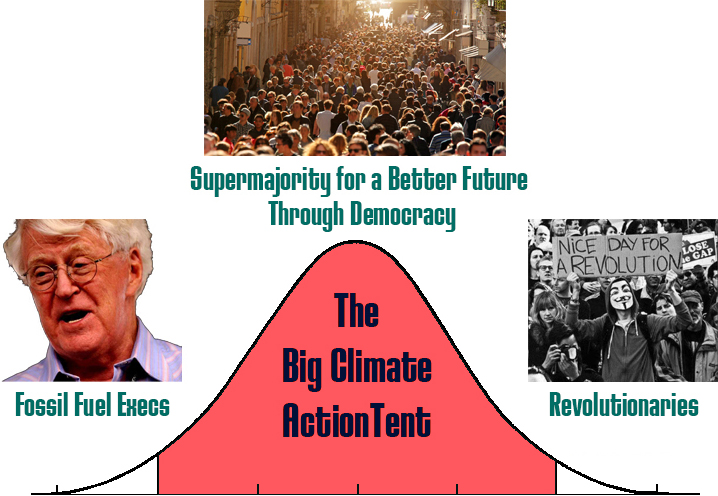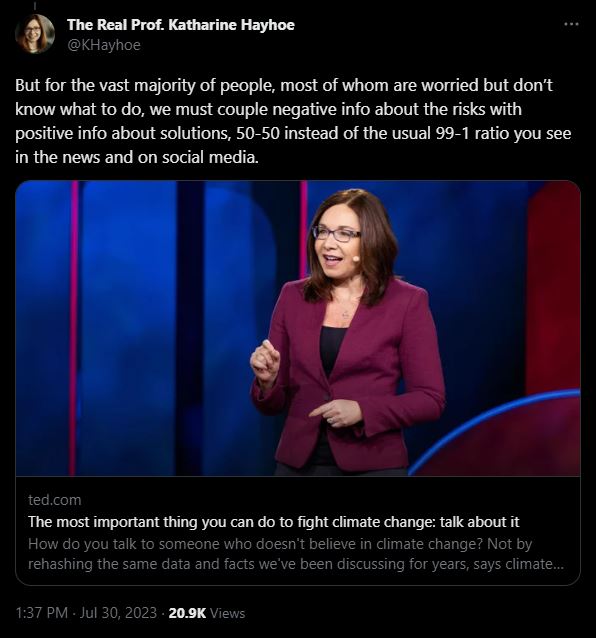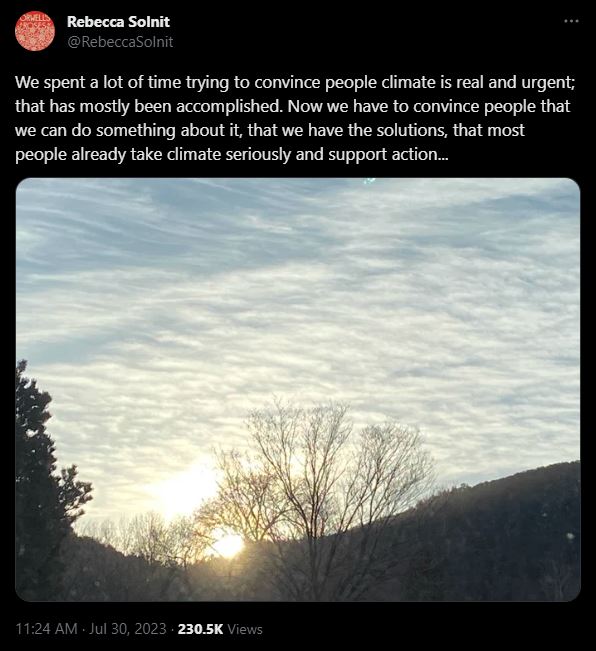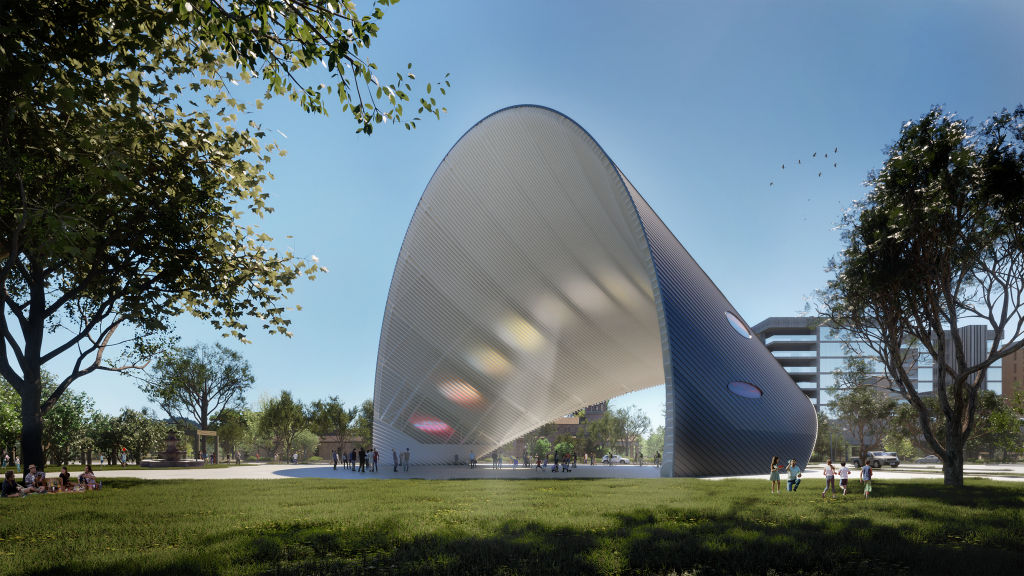Header Image: The Solar Hourglass by Santiago Muros Cortés is the winner of the 2014 Land Art Generator Initiative design competition for Copenhagen. It generates 7,500 megawatt-hours of electricity each year using concentrated solar power (thermal beam-down with heliostats). As an hourglass this public artwork reminds us that there is still time to avert the worst effects of climate change—a climate solution with a strong and inspiring message.
The strategy of climate apocalypse has lost its effectiveness and it’s time for something new.
If we want rapid and massive change then we have to start organizing effectively and build a large, winning political coalition. This post is a guide for how to start doing just that.
How did we get here?
Since the 1980’s scientists have been doing their very best to capture the public consciousness around what may be the most serious threat to human civilization. The first couple decades went moderately well. Campaigns always take time to gain momentum. At first global warming was a bipartisan effort. George H.W. Bush heralded the success of the Montreal Protocol that saved the ozone layer from CFCs and said at a press conference in 1988:
I’d immediately begin to address some of the major challenges that confront us this summer as we’ve seen a lot of talk about the greenhouse effect. As the nations grow they burn increasing amounts of fossil fuels, and that gives off carbon dioxide which acts as a blanket…Some issues can’t be solved by individuals alone. On these there is a role for government. There is a need for leadership. And let me tell you how I would lead as president I would start by integrating environmental considerations into all policy decisions…
But something went sideways in the years that followed, as fossil fuel companies began a very expensive campaign of media misinformation, influence peddling, higher education funding, politician buying, and general purpose water muddying. They had known the truth behind the science since the late 1960s and their actions are absolutely on par with those of big tobacco. You can’t really blame them though. Climate change may have represented an existential threat to the balance of life on Earth but the energy transition posed an existential threat to their business model. They had a legal duty to earn returns for their shareholders and donations to the Heritage Foundation and Jones Day became the necessary overhead to accomplish that end.
As the modern climate movement came of age in this storm of information warfare, activists felt the need to communicate in a way that could somehow balance the scales in the opposite direction. To combat accusations of uncertainty, we felt we had to communicate climate model projections with as much certainty as possible. Using those models we made information graphics and movies about climate doom, gloom, and apocalypse—spreading desertification; collapsed governments; crop failure; drowning, frozen, and burning cities; mass migration—thinking we could shout loudly enough through the muddy waters to be heard above the Wall Street Journal Op-Eds. We villainized millions of people who make a living in the energy industry because it was an expedient way to build an incensed activist base. Using bullying as a tactic we called millions of our fellow citizens morons for buying cars with V8 engines or voting for politicians in the pocket of big oil. We fell victim to the framing about individual carbon footprints and casually welcomed the tactic of shame into the movement.
Some of these tactics worked for a while, opening the eyes of those who were not familiar with the science or who hadn’t fully grasped the severity of the problem. In the wake of Hurricane Katrina Vice President Al Gore’s movie “An Inconvenient Truth” and the Climate Reality Project it gave birth to had a real impact and opened the door to the Paris Accord. Through no fault of Mr. Gore’s it also helped to position climate change as a thoroughly partisan issue. Villains were established on both sides.
By the end of the first Obama Administration, the marginal benefit of apocalyptic climate communication to win over new followers began to drop precipitously. A nearly 100% focus on a fear-based communications strategy that has continued with recent movies like “Don’t Look Up” has by now failed to establish the super majority of political momentum needed to pass massive climate legislation on a scale sufficient to meet the challenge.
At some point after consciousness has been raised you can stop violently shaking the patient.
Time for a pivot
Today we are still living at the end of the era of climate apocalypse communications and we are hungry for a new narrative.
Those who we need to reach are fast falling victim to doomerism and a sense of futurelessness and apathy about the ability of liberal democracy to deliver positive change and to address the injustices being perpetrated daily on society and the environment.
Those who cannot imagine a better future are not motivated to vote.
How can we shift the way we communicate climate change and the energy transition so as to build that massive and overwhelming support for policies that can get the world to net-zero and the politicians who can lead boldly in that fight without fear of reprisal?
A successful and large enough coalition will be bipartisan. It will include people who work in the energy industry. It will include people who risk their lives stopping new gas pipelines. It will include people who fly, drive old pickup trucks, and use gas powered leaf blowers. It will include people who are a little skeptical of climate scientists and people who hate Al Gore. It will include people with grass lawns and plastic lawns. It will include all political stripes. It will include people of all races, genders, religions, abilities, and sexual orientations.
With an inspiring and consistent message we can bring all of these people into the climate action tent. Not everyone of course. On one side we will always have people who have a financial interest in the combustion of fossil fuels for energy and on the other we will have people who have given up entirely on the political process. We can simply ignore the fossil fuel executives and those with vested interests, secure in the knowledge that they will grudgingly move forward when pulled by the rest of society. As for the revolutionaries who have abandoned all hope for peaceful change through the ballot box, we can continue to engage them and—as policy evolves to better meet their expectations of how democracy should work to equitably meet the needs of the people and empower the governed in life, liberty, and the pursuit of happiness—we may have hope to win them over eventually. The industrial policies in the IRA are just the tiniest move in that direction, and every journey begins with a single step.
It is also important to remember that the latest consensus on climate modeling is that the day we get to net-zero emissions—in other words the day humans no longer add greenhouse gases to the atmosphere above our pre-industrial contributions—is the day that warming stops. As climate scientist Zeke Hausfather puts it, “humans have the power to choose their climate future.” There is no “baked-in” warming if we can avoid runaway feedbacks. To that end (avoiding feedback loops), time is absolutely of the essence and therefore a politically effective climate communications strategy should be our primary focus.
Today, as we are seeing clearly the warming effects enhanced by a strong El Niño weather pattern, it is more important than ever to make sure people understand that this is reversible if we act swiftly, that all is not indeed lost.

Steps to effective climate communications
Step 1. Plant the seed of DESIRE
Even before talking about the science, start by talking about how wonderful and improved life will be in a future where we no longer must rely on burning carbon for our energy. For starters, 8 million people will no longer die every year from fossil fuel air pollution. And with endless supplies of energy where the feedstock comes free from the sun, we will enter an era of energy abundance that will radically improve the lives of people everywhere. Continue this narrative in Step 3.
Step 2. Help young people to understand the scientific basis for climate action. For anyone over 30 it is a waste of your time engaging in scientific “debate.”
If someone is unwilling to grasp the very simple concept of the greenhouse effect there is no amount of effort that can ever convince them. If someone responds with questions about solar cycles or, “but isn’t CO2 actually good?” you can provide debunking information, but after one or two times additional engagement will not be worth your time.
The Scientific Basis summary in the IPCC Sixth assessment is the most complete place to find information. For a very simple overview, check out the EPA’s explainer page.
Step 3. Explain how we can solve climate change by drawing down greenhouse gas emissions using existing technology, and how a modernized grid will bring an end to air pollution, make energy more reliable, affordable, and democratic, and improve the quality of life for everyone.
This can be done following any number of well-researched socio-technical pathways (e.g. this, this, this, and this) and through various technology combinations: energy efficiency wherever it makes sense; wind and solar as the electric power workhorse; hydro, geothermal, and some nuclear power as steady clean-firm; green hydrogen for fertilizers, synthetic methanol, and emergency backup power; energy storage of all durations with batteries, pumped hydro, thermal storage; and at the margins some carbon capture along the way.
As much as possible, these infrastructures should be designed in collaboration or close consultation with communities where they are located and provide social co-benefits that can help to advance the perception of carbon-free energy in the mind of the public.
This second step is the hardest part, and it is largely now the focus of the fossil fuel lobby’s online disinformation campaigns that dismiss solutions as naive despite the fact that many of them are being deployed successfully today. It might be important to get ahead of some of the bad information about wind and solar farms. For example, wind turbines are not a threat to bird populations (climate is), they don’t cause health problems from infrasound, and offshore wind doesn’t hurt whales. Solar panels do not pollute groundwater. Both solar and wind can coexist wonderfully with agricultural landscapes.
In order to get this step right we have to be inclusive. No infighting! All technically viable solutions to reduce greenhouse gas emissions and capture carbon are on the table. That includes every kind of renewable energy at every scale. It includes energy storage technologies of every kind and every opportunity to replace gas combustion with electrical appliances. It also includes nuclear power and some carbon capture.
Each of these technologies must be considered in the context of their other environmental impacts to water, soil, living biomass, habitat. They must be considered in the context of their social impacts as well and priority should be placed on implementing the least environmentally harmful projects that have the greatest social upsides.
We must recognize that systems of infrastructure are interconnected with natural systems and social systems. By co-designing solutions with people, we can transfer knowledge, not just hardware. The energy transition is something we build together, it is not something that is done to us.
Provide examples of how we are already making progress and how the solutions are more economically efficient than maintaining the status quo. Sell this part by planting a seed of desire. Talk about energy abundance. If you get this part right you may even pick back up some of the deniers when they conclude the energy transition is a good idea, warming or no warming.
Step 4. Avoid talking too much about sacrifice, degrowth, economic contraction, the great simplification awaiting us when the carbon bubble pops, or any variation on these themes. They are a self-fulfilling prophecy.
Don’t add economic doom on top of climate doom. While the temptation to do so is great, and the clicks will surely follow from that kind of doom-scroll bait, all this will do over time is create more division where we need to instead build more solidarity.
By focusing on an end-of-days narrative, you also provide fuel to the deniers who will go out of their way to point out you and your arguments as “chicken littles” when the sky fails to fall in the time span you suggest that it might. Do not turn climate action into a doomsday religion.
Step 5. Do not vilify anyone.
We live in a system where millions of people are dependent upon our existing ways of making and consuming energy. Build bridges by meeting folks where they are at. For those who work in the fossil fuel industry, talk about the opportunities for hydraulic fracturing drilling technology to transfer to enhanced geothermal. Point to Fervo Energy, whose founder came from the oil and gas industry as one example among many.
Yes it’s true that private planes are terrible and that the footprint of the 1% is a large part of the problem. It is understandable to come to the conclusion that the message should therefore be “eat the rich,” but the rich are also a powerful part of the coalition we need to build. It’s fine to talk about progressive economic policy in the context of climate action. There is a lot of intersectionality to be leveraged there. The communications strategy toward the 1% should not be that we are going to eat them, but rather that their world will also be improved by a 100% renewable energy powered equitable circular economy with healthy air, healthy food, and a healthy population of well-off consumers who will continue to buy the products and services that their companies sell.
Step 6. Be kind to those with whom you disagree.
It is sometimes easy to make a target out of what you perceive to be stupidity and those memes can get some traction. But all you are really doing is shooting the climate movement in the foot as you deepen social rifts, encourage tribalism, and set polarization of climate action into stone. This is exactly what the fossil fuel executives would like to see happen. When climate action can be framed as a pet issue for the “left” then we have lost roughly half of our potential coalition.
Step 7. Be the change you wish to see.
There is a place for peaceful protest and civil disobedience. When you cross the line to property destruction or violence you stop acting as a force of change for good and you begin to operate as a force for chaos. Your brave and noble actions will be applauded by an already enlightened, frightened, and outraged base, but you will win over very few who were not already on board.
Instead, enjoy time performatively with your friends and fellow activists in the shade of solar PV canopies or organize your neighborhood to build a community solar park if you don’t already have one. Demonstrate how great your new induction range is. Talk about how much better the vegetables are that you get at the local farmer’s market. Highlight the benefits of a car free lifestyle or of living with a car that has no exhaust or internal combustion engine to leak oil or break down. Enjoy affordable heat in the dead of winter from your whole home heat pump. Do all of these things together with hundreds of people at once so that the audience you attract is inspired and filled with emotion by what is possible.
Change will come because the public sees these replacements as undeniable improvements over the old versions. Madison Avenue creative agencies never scared people into buying internal combustion engine cars or shamed them into buying disposable plastic stuff. They tempted them. Likewise, climate action must be at least as tempting, and preferable more so.
The tide is already shifting!
There are a number of influential climate activists who are taking this turn toward hope and building a narrative around better post-carbon futures.


But there is clearly a lot of work left to do and many imaginations left to inspire with reality-based stories of the benefits of life in a world that no longer burns fossil fuel for energy.


These folks may be won over, but not with fear or shame. Only by desire.
So help sow these seeds of desire with your family, your friends, your social networks, your coworkers, and your followers. Organize your community to support pro-renewable energy zoning. Get together to build new community solar projects and establish clean energy cooperatives.
While you do so, remember that renewable energy can be beautiful and it can share space with gardens, parks, public artwork, trails, and farms. Our future is what we make it.

If you are looking for sources of information on the feasibility and benefits of the energy transition, please check out the following journalists, researchers, policymakers, scientists, and investors who have been doing the hard work of cutting through the noise and disinformation and seeking out solutions.
- Volts | David Roberts
- Net-Zero America
- REPEAT | Rapid Energy Policy Evaluation & Analysis Toolkit
- RMI
- The Solutions Project – Let’s create the future we want.
- The Energy Transition Show | XE Network
- Local Energy Rules Podcast Homepage
- A Matter of Degrees – stories for the climate curious
- Catalyst – Post Script Media
- MCJ Collective: Unleashing Climate Innovation
- The Carbon Copy – Post Script Media
- Rewiring America
- The Energy Gang | Weekly Business Podcast on Energy, Cleantech and the Environment
UPDATE August 1, 2023: For a very thorough analysis of the social science on politically effective climate communications check out this excellent paper by Dr. Genevieve Guenther: “Communicating the climate emergency: imagination, emotion, action.”
We differ slightly with her bottom line conclusion in that Dr. Guenther places equal value on Fear, Outrage, and Desire, whereas we think it is time to start downplaying Fear and Outrage and focus almost exclusively on Desire, especially now that the technology that will end fossil fuel combustion while also improving our lives is very much ready for prime time.
It is important as she says to avoid too much “reassurance that technical solutions to the climate crisis exist” without also making sure people understand the enormity of the systems change that the massive deployment of that technology will entail, and that such massive change requires getting out the vote and empowering new leadership that understands clearly what must be done and the investments that are required. We completely endorse her powerful concluding sentence:
There is no greater task for climate-change communicators now than telling the stories that will bring that world into being.”

